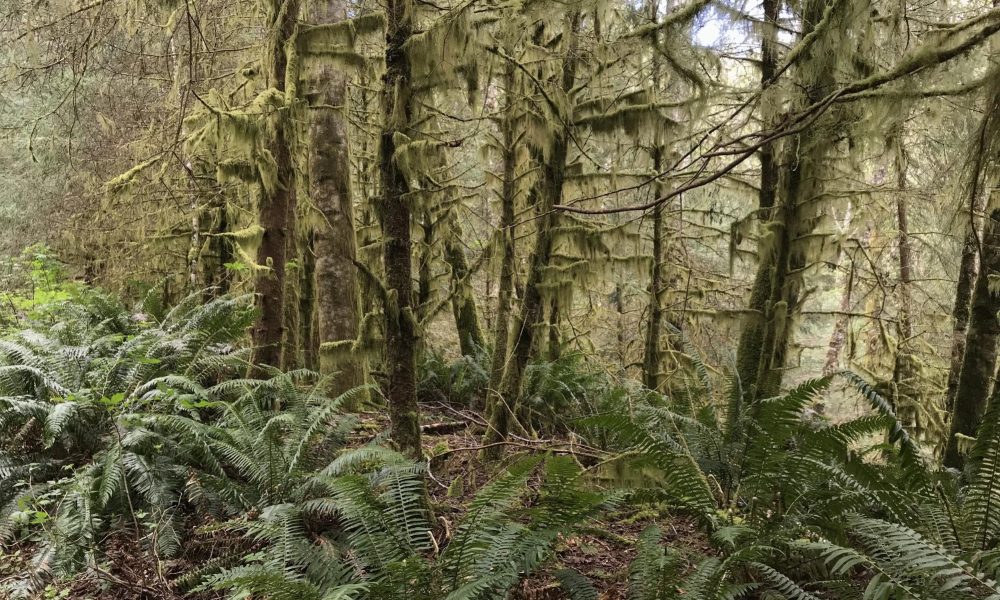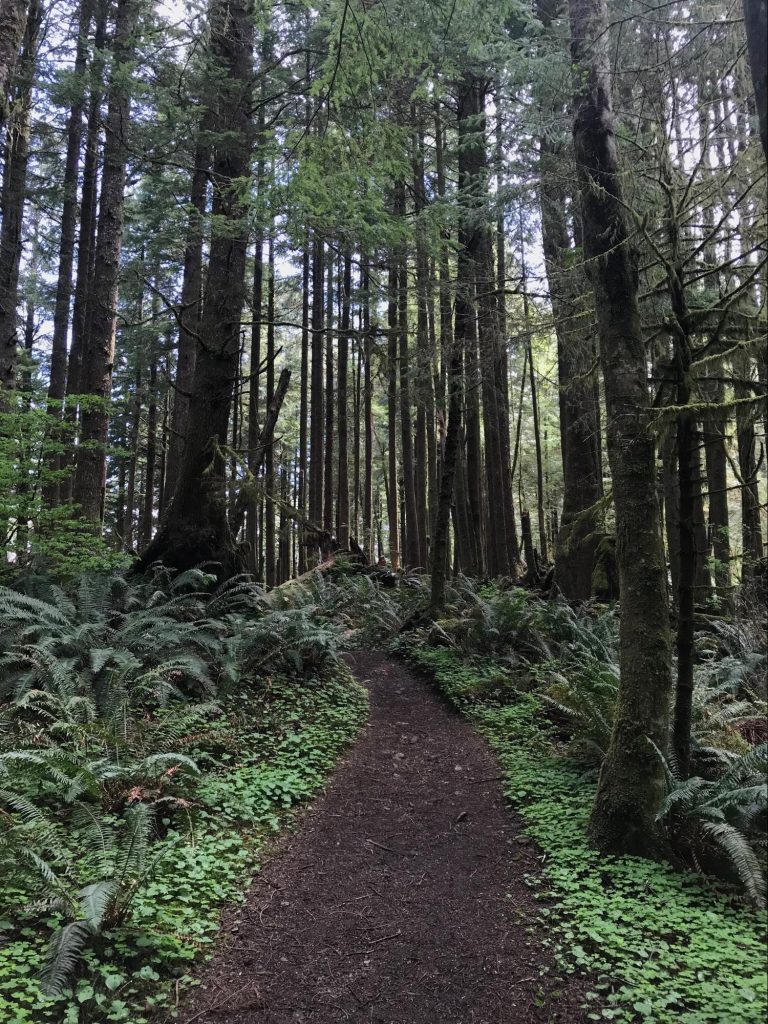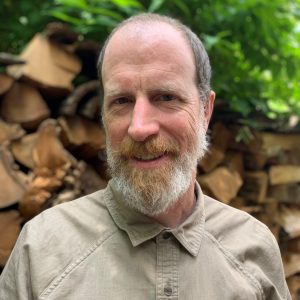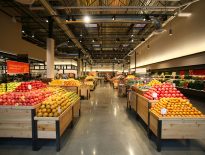This post is written by a guest author, Walter Lourie. Walter is the head of sustainability for the Austria-based company mafi, which creates natural wood flooring and engages with ILFI’s Living Product Challenge. Check out their Imperative Certified product here.
It was a Bluebird day in August when I boarded the Cessna in Juneau and I could not help but have some jitters, even though traveling throughout the panhandle of Alaska via small aircraft is usually safe. The endless view was spectacular and I wished that I could’ve spent the day up there exploring the mountain ranges, valleys, and deltas that I wouldn’t normally get to see in the typical grey and cloudy Southeast Alaska weather. Josh, my liaison from the logging group who manages the crew here, met me on the ground in Hoonah. It’s a very small town on Chichagof Island within the Tongass National Forest. This former salmon-canning town had become a logging camp, where the forestry business is the lifeblood of the village. With the airstrip and big ship harbor nearly attached to the village, it was a hive of activity every day of the year.
We jumped in Josh’s green pick-up and headed up through Whitestone Logging Camp to gain access to the latest logging road network, spanning nearly the entire 75-mile-long island and interconnecting with other nearby islands. It’s a huge clear-cut logging operation that had been active for more than 50 years. We started the 20-mile-long drive past numbered signs indicating pull-off locations, and as we drove, Josh called out when we passed these markers on the company radio. We heard back from the other vehicles on the road from their various locations. We could tell from the calls that there were three logging trucks nearby—two ahead and one behind. The two ahead were loaded with a “big turn,” or load of logs, and barreling down the road toward us. Careful timing of passing oncoming vehicles is crucial, especially on this single lane road carved out of the side of a mountain, a primitive dirt track with nerve-racking guardrail-less sides. When facing an oncoming “Mad Max” style truck (imagine a pile of logs with a steering wheel screwed to the front end) loaded with 100,000 pounds of 4-foot plus wide trees going 30 mph, it’s a good idea to avoid such an encounter.
In the early 1990s I was a property claims insurance adjuster based out of Anchorage and I was there because of an accident. Caterpillar Machinery Company makes a 49 ton, Model 350 L excavator that this logging group used as a “pioneer” to clear the way of stumps and debris, but also to level gullies and ridges to make logging access roads, including the very one on which we were currently traveling. The “Cat” is so huge that the scoop on the end of the massive articulating arm was big enough for me to stand in and spread my arms without touching the sides. I was told that the accident occurred when the Catskinner (operator) was reaching across a gully on the hillside opposite his position. Precariously perched in this way, it was easy to see how the excavator lost its footing and slid sideways down the hill. The skinner panicked and bailed safely out of the cab, leaving the $400,000 machine to its path of destiny. The behemoth gracefully descended 360 feet sideways down the hillside, and if it hadn’t found the next road it could’ve easily plunged into the deep gorge just a bit further below.
Fortunately, it hit the berm of the road below and the momentum flipped it upside down onto the top of the cab. The insurance company asked me to take photos, document the scene, and talk with the insured. Later I found out that it cost $90,000 to fix the machine and a meager $25,000 to get it off the mountain and on a barge across the Icy Straight to the repair shop in Juneau.
Mountainside observations…
I spent a lot of time talking with Josh about what happens here on the mountain. His operation was a typical Northwestern US and Canada style of resource extraction. Someone decided—and an elected government authorized—that the clear-cutting of a forest was both allowable and efficient. I won’t mince words here that I was impressed at the efficiency. It was the total and complete removal of everything standing, and these professionals made it look easy. I asked about the timeline of the cuts at the hillside we were standing on at the time. He said it had been completed about 15 years before. The natural new growth was architectural and lean, like Spartan soldiers standing at the ready, jam-packed with 25- to 30-feet tall green spears aiming for the sky. The recovery was spectacular and impressive for its age. The stand we witnessed uphill from there was five years old and stuffed to the gills with naturally-seeded baby trees about 8-10 feet high. They were so thick that Josh said for optimum growth they would need to thin the stand in the next few years. It was completely loaded with birds, bees and lots of crawling things.
… and Japan wins
Finally, we got back to the lower landing after another harrowing ride, this time behind a loaded truck, to then see the entirety of the harvest being loaded onto ships destined for Japan! These irreplaceable logs were to be buried in the Sea of Japan for preservation, for future demand from the Japanese market. This was 1994. A few years after my visit, the clear-cutting had ceased and according to the city of Hoonah, the forests and subsequent ecosystems are recovering with tenacity. Satellite images show the obvious difference from the old growth and the previously clear-cut forests, and they may never be the same as the old growth that took thousands of years to develop. However, the state of Alaska, the US Forest Service, other government agencies, as well as environmental groups and the local Indigenous people, are hard at work developing a sustainable management plan for the future. It was heart wrenching and disturbing to see all that was lost up there, but at the same time, looking at it from the loggers perspective and the amazing natural recovery gives me an open-minded perspective of hopefulness about the potential for future generations of forests. Especially when you attach sustainable forestry practices for management. Speculation could go on for pages but we don’t have time for that here, and hopefully we have learned a thing or two about delicate natural biodiversity enough to avoid massive extraction of this gorgeous forest for the benefit of others.
Many parts of the world have already created sustainable carbon-friendly forest management plans. Austria was the first in 1853 when they enacted the national forest law. At the mafi company, as a means of company resilience, we have believed for our entire 100 year existence as a wood products producer that the forest is precious and we must preserve it for future generations. There is not an unexplored territory to which we can or should exploit for resources, as the European imperialists did. This developed and legislated a sustainable forest in Austria forever. Even without such laws, our very own forests in the United States cover 50% more of the nation than they did in 1950. For every single hardwood tree cut down, nature replaces it with 2.4 trees herself. This means self-regenerating forests are happening and we are better off to let them! It’s interesting despite all the time we spend trying to figure out what the best plan is for future climate initiatives, nature already has a plan and most of the time we just get in the way.
Collecting ideas using nature as the designer…
We know our building materials are a key component of any climate initiative. For thousands of years, buildings were made of whatever materials were locally available, and wood has been the primary building product for most cultures. Some of these structures have withstood the test of time. An example of the resilience of natural materials is the Heddal Stave Church in Norway, which was built entirely out of wood in the 13th century. The reason it has survived this long is that wood has an ability to balance humidity. There is a simple surface preservation technique using natural oils. This does not create a barrier layer, allowing wood to take in and remove moisture; therefore it remains flexible and resilient during seasonal changes. Cleaning with water and soap when necessary helps to give wood back the moisture it had during its life in the forest. This natural action is crucial to the longevity of natural materials. They are left as they are— not “protected” by man-made barriers such as polyurethanes or varnishes that cut off the air movement. It is said the wooden roof shingles on the church are coated with pine tar for preservation only every 60 years or so.
Learning…
The carbon-wasting concrete and steel architecture style has dominated our large-scale commercial projects, and comparatively, those buildings have a relatively short lifespan. Look at examples like bridges, offices, and parking garages that were built in the 1950s, 60s, and even as late as the 90s that are coming down by the thousands, wasting all that embodied CO2. Imagine if we had built all of those shopping malls with modular components that could be repurposed. Notice now how building with CLT (cross-laminated timbers) is making dramatic progress in sustainable carbon neutral design. These projects are way ahead of the game even before they go up, and with basic maintenance, they can last as long as the Heddal church.
Architects, designers, specifiers, developers, consultants, and homeowners can have it all—sound structures that also take into account the value of nature. Our trip to the Tongass showed me the vast chasm we have created between nature and our built environment. In Zoom meetings, webinars, and conferences, we talk about how better technologies and methods can save our species. This may represent looking at design and innovation through the wrong end of the binoculars. All of us breathing the air provided to us by the sun through plants must consider that we wouldn’t even be here without nature and that we are an integral part of it. We are not separate from it and we need to recognize we cannot live long without sustaining it. Traditional solutions like creating new ways to recycle plastics—but still using them to begin with—is an eventual dead-end.
Fixing our out-of-touch relationship with nature will change everything. This would start with us stepping out of our front door and ending the practice of using chemicals to kill insects or weeds, and growing less monoculture lawn while cultivating native landscapes for pollinators and animals. We can all consider stopping the purchase of our food in a box wrapped in plastic, even if it says it has “natural ingredients.” Alternately, find out who your local food producers are, and look for no-till regenerative farmers who harvest carbon using plants and animals, like White Oak Pastures that sells net-carbon-negative beef. Perhaps reconsider stepping into the biggest new car you can buy every time there is better financing.
I invite the design community to lead the effort and use their power as influencers to inspire clients to seek ways to authentically connect with nature, rather than use the least-expensive, man-made imitators. Can we start adhering to the Living Building Challenge standards to improve the well being of the building occupants and the natural world around us? This practice would demonstrate you are a leader by example, one who wants to show how to really make a difference.
Leaders are teachers
As a leader, you would be using Living Product Challenge products like Imperative-certified mafi wood planks, which are completely natural, stable, and healthy. What more do we need to do to make it clear that Living Product and Declare manufacturers have committed and are seriously leading the way? Will you unite with us and lead too? Architects can sign the AIA materials pledge letter. Specifiers can become habitual in the proliferation of natural products, starting with the most used surface in all projects, the floor. Now is the chance to prove the design community’s drive to live by standards in which you truly believe. Show manufacturers like us at mafi that you are engaged and willing to support the mission of a Living Future by using certified products.
Our path toward a renewable, regenerative living future relies on just this. Remember that the work it takes to fulfill a Living Product Challenge certificate on any level is difficult, expensive, and most of all, important. Architects and specifiers have asked for the most stringent standards for transparency and for regenerative, resilient building standards, namely the Living Building Challenge and the Living Product Challenge. Unlike the carbon harvesters of the Tongass, mafi has obtained its natural products from within our protected forests in Austria and partner countries. For more than 100 years we have been partners with our neighbors who rely on those forests in Upper Austria and carefully managed them even before the 1853 national forest law. We have recently gone through the process of a Living Product Challenge, and our Cradle-to-Grave LCA showed we are Net Carbon Negative through stages A1-A3. We plan to continually work on transparency and will develop our leadership roles as stewards of nature. We need your help. We need to be in your projects and in your minds when you are designing a healthy space. The alternative looks bleak: societies consuming over-extracted minerals and resources, using questionable methods to fashion useless products, and exploiting human labor in factories with no accountability.
Companies like mafi have shown it is possible to produce and deliver healthy Living Products that benefit humanity and the future of our planet without damaging society or our natural ecology. mafi wood, specifically, has an innate value as an interior material because of its unadulterated natural surface. Wood surfaces are familiar to us, the effervescence and the texture, even simply being near wood has been proven to relax our senses and reduce stress. It has also been proven that a natural wood surface is hygienic and does not require harsh chemical cleaners. Wood has resilience, proven not only by the Stave church in Norway but by examples of wood floors that have endured for centuries in buildings worldwide. I believe anyone would agree that successful regenerative or biophilic designs does not include the proliferation of recycled plastic replicas or imitations. What I find hard to believe is that architects build “sustainable projects” and are okay with the current use of artificial products. Maybe it is because they do not know the alternatives?
Let us take a lesson from the Tongass and Josh in Hoonah. Our relationship with nature is broken like that Cat 350 L, and we can’t be the Catskinner who bailed out at the last moment, letting our world slide down the hillside. We all know the way to fix a relationship is to work on it—by embracing the challenge together. We can make a difference and we don’t need more than what we’ve already got…a true treasure trove of natural products. The path has been laid by nature, so let us follow it.







